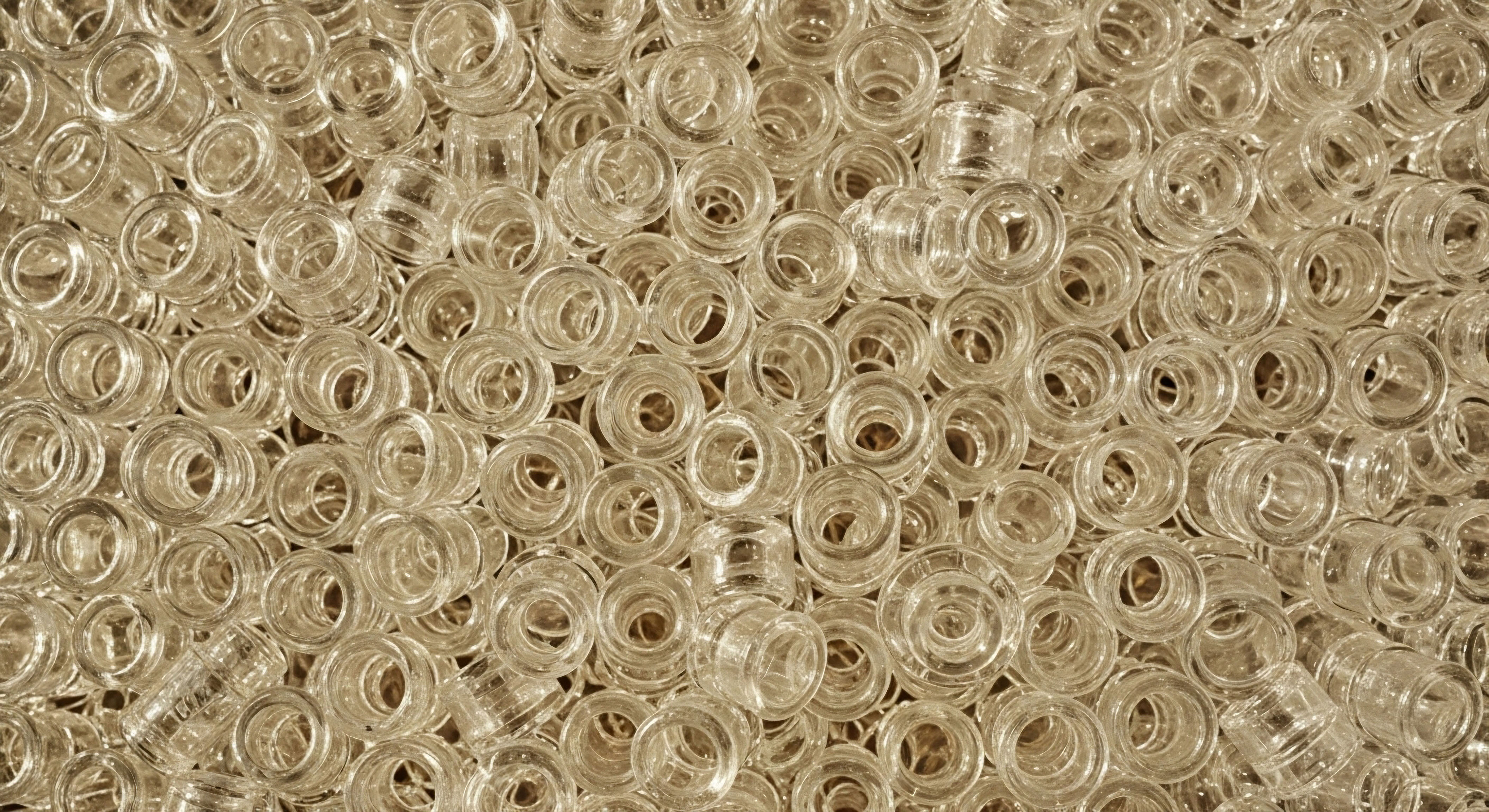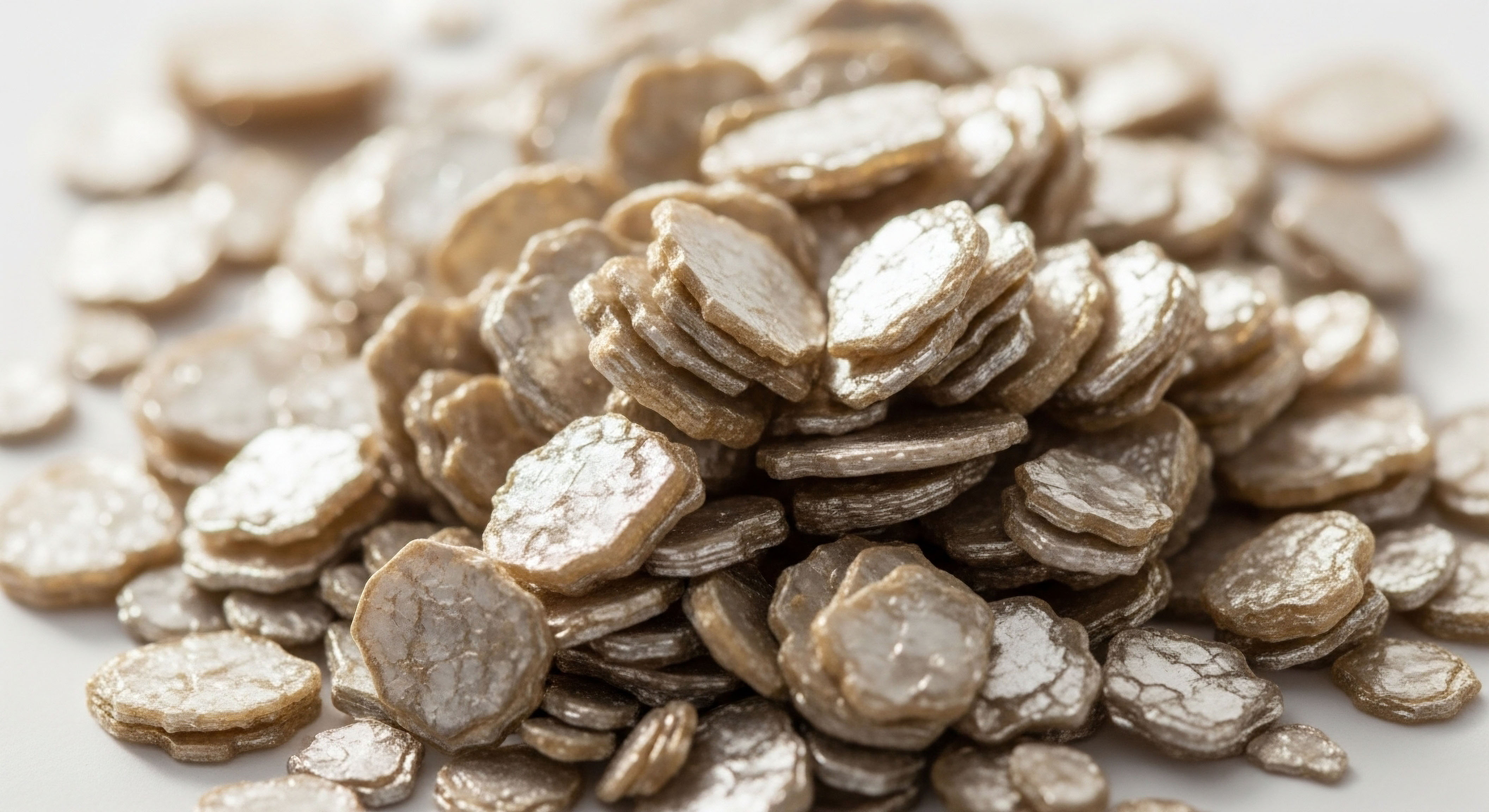

Fundamentals
You have embarked on a protocol to optimize your body’s hormonal environment. You are likely familiar with the process of administering testosterone cypionate, perhaps alongside gonadorelin to maintain testicular function, and anastrozole to manage the conversion of testosterone to estrogen. The initial results may have been significant, a welcome return of vitality, mental clarity, and physical strength.
Yet, you might be sensing that the full picture is more complex. Perhaps you notice subtle shifts in mood, water retention, or a plateau in your progress, despite adhering strictly to your prescribed regimen. This experience is common, and it points to a foundational principle of human physiology ∞ a therapeutic protocol does not operate in a vacuum.
Your daily choices, the foods you consume, the way you move your body, and the stress you encounter are not passive variables. They are active participants in a constant biochemical conversation with the hormones you are introducing.
The central question then becomes, can these lifestyle factors still influence estrogen balance even when you are on an optimized protocol? The answer is an unequivocal yes. The administration of exogenous testosterone provides the raw material, but your body’s internal environment dictates how that material is processed, converted, and metabolized.
Understanding this interaction is the key to moving from a state of simply supplementing hormones to truly managing your endocrine system as a whole. This is not about overriding your protocol, but about creating the most favorable internal conditions for it to succeed.

The Central Role of Aromatase
At the heart of this conversation is an enzyme called aromatase. This enzyme is responsible for a process known as aromatization, which converts androgens (like testosterone) into estrogens. Aromatase is not confined to a single gland; it is found throughout the body, most notably in adipose tissue (body fat), but also in the brain, bones, and blood vessels.
For men on testosterone replacement therapy (TRT), this process is of particular importance. While anastrozole is prescribed specifically to inhibit the aromatase enzyme, its action is systemic and dose-dependent. It does not eliminate all aromatase activity, nor would that be desirable. Estrogen is a vital hormone for men, contributing to bone density, cardiovascular health, and even libido. The goal is balance, not eradication.
Lifestyle factors directly influence the amount and activity of aromatase in your body. The most significant of these is body composition. Adipose tissue is a primary site of aromatase production. A higher percentage of body fat means you have a larger “factory” for converting the testosterone from your injections into estrogen.
This is a direct, mechanistic link. Even with an aromatase inhibitor on board, a greater amount of the enzyme requires a more significant inhibitory effect to maintain estrogen within the optimal range. This is why individuals with higher body fat percentages often require more careful management of estrogen-related side effects like water retention or gynecomastia.
Your daily habits are not separate from your hormonal protocol; they are the environment in which it operates.

Estrogen Metabolism the Body’s Cleanup Crew
Once estrogen is created, either through aromatization or administered directly, it circulates in the bloodstream and carries out its functions. It does not, however, remain in the body indefinitely. The liver is the primary organ responsible for metabolizing, or breaking down, estrogen so it can be excreted.
This process occurs in two main phases, known as Phase I and Phase II detoxification. Think of this as a two-step cleanup process. Phase I, driven by a family of enzymes called cytochrome P450, modifies the estrogen molecule. Phase II attaches another molecule to it (a process called conjugation), making it water-soluble and ready for elimination through bile and urine.
Here again, lifestyle choices exert considerable influence. The liver’s capacity to perform these functions depends on a steady supply of specific nutrients. B vitamins, for instance, are critical cofactors for these enzymatic reactions. A diet deficient in these micronutrients can slow down the metabolic assembly line, leading to a backlog of estrogen metabolites.
Alcohol consumption places a direct burden on the liver, competing for the same metabolic pathways required for estrogen clearance. When the liver is preoccupied with processing alcohol, its ability to effectively metabolize hormones is diminished, potentially leading to an accumulation of estrogen. This demonstrates that your protocol’s success is not just about what you put in, but also about ensuring the body’s natural clearance systems are running efficiently.

How Do Lifestyle Choices Directly Impact Hormone Pathways?
It is useful to categorize the ways your daily life interacts with your endocrine system. These are not abstract concepts but tangible biological inputs that can either support or hinder your optimization goals.
- Dietary Inputs ∞ The food you eat provides the building blocks and instructional signals for hormone metabolism. Cruciferous vegetables like broccoli and cauliflower contain compounds such as indole-3-carbinol (I3C), which can favorably influence estrogen metabolism pathways in the liver. Fiber intake is another critical component, as it binds to metabolized estrogens in the gut, ensuring their final excretion from the body. Without adequate fiber, a portion of this estrogen can be reabsorbed back into circulation, undermining the clearance process.
- Physical Activity ∞ Exercise impacts estrogen balance through several mechanisms. Resistance training helps build lean muscle mass and reduce body fat, thereby shrinking the size of the body’s primary aromatase factory. Regular physical activity also improves insulin sensitivity. Poor insulin sensitivity, or insulin resistance, is often associated with increased inflammation and higher levels of aromatase activity, creating a cycle that favors estrogen production.
- Stress and Recovery ∞ The body’s stress response system, known as the Hypothalamic-Pituitary-Adrenal (HPA) axis, is intricately linked with the reproductive axis (the Hypothalamic-Pituitary-Gonadal, or HPG, axis). Chronic stress leads to elevated levels of the hormone cortisol. Cortisol production can divert metabolic resources away from the production of sex hormones. Furthermore, the physiological state created by chronic stress can promote fat storage and inflammation, indirectly supporting higher aromatase activity and estrogen levels. Adequate sleep is essential for regulating cortisol and allowing the entire endocrine system to recover and recalibrate.
Understanding these fundamental connections is the first step. Your hormonal health is not a static state achieved by a prescription alone. It is a dynamic equilibrium, constantly responding to the powerful signals sent by your lifestyle choices. These choices do not override your therapy; they determine its ultimate effectiveness and your overall sense of well-being.


Intermediate
For the individual engaged in a hormonal optimization protocol, the initial phase often focuses on establishing correct dosages of agents like testosterone cypionate and anastrozole. This process creates a new, stable baseline for circulating hormones. However, achieving true optimization requires moving beyond this baseline to understand the dynamic systems that process these hormones.
Lifestyle factors are not merely “helpers”; they are potent modulators of the very pathways your clinical protocol targets. Their influence is observable in your lab results, your physical response, and your subjective sense of well-being. A deeper examination of these mechanisms reveals precisely how diet, exercise, and stress management directly interface with your endocrine function.

The Gut Microbiome the Estrogen Recycling Center
One of the most significant modulators of estrogen balance is the collection of microorganisms residing in your gut, collectively known as the gut microbiome. Within this complex ecosystem exists a specific subset of bacteria with genes capable of metabolizing estrogens. This collection of microbes is termed the estrobolome.
Its primary function is to regulate the enterohepatic circulation of estrogens. After the liver metabolizes estrogen through conjugation (Phase II detoxification), these conjugated forms are excreted into the gut via bile, destined for elimination. However, certain bacteria in the estrobolome produce an enzyme called β-glucuronidase.
This enzyme can “deconjugate” the estrogen, essentially snipping off the water-soluble tag the liver attached. This action reverts the estrogen back into its active form, allowing it to be reabsorbed through the intestinal wall and back into circulation.
The activity of your estrobolome can have profound implications for someone on a hormonal protocol. A healthy, diverse microbiome maintains a balanced level of β-glucuronidase activity, allowing for appropriate excretion of excess estrogen.
Conversely, a state of gut dysbiosis ∞ an imbalance in the microbial community, often driven by a low-fiber diet, excessive alcohol intake, or antibiotic use ∞ can lead to an overproduction of β-glucuronidase. This results in excessive deconjugation and reabsorption of estrogen.
For an individual on TRT, this means that even if aromatization is well-controlled by anastrozole, a dysfunctional gut can re-introduce a significant amount of active estrogen back into the system, potentially leading to elevated levels and associated side effects. This mechanism explains why individuals with seemingly perfect protocols can still struggle with estrogen management if their gut health is compromised.
The state of your gut microbiome can directly determine whether your body excretes or recycles estrogen.
Strategies to support a healthy estrobolome are therefore a critical component of managing estrogen balance. This involves:
- A High-Fiber Diet ∞ Soluble and insoluble fiber from a wide variety of plant sources (vegetables, fruits, legumes, whole grains) provides fuel for beneficial gut bacteria and helps bind estrogen for excretion.
- Probiotic and Fermented Foods ∞ Foods like yogurt, kefir, sauerkraut, and kimchi introduce beneficial bacterial species, such as Lactobacillus and Bifidobacterium, which can help maintain a healthy microbial balance.
- Limiting Alcohol and Processed Foods ∞ These can promote the growth of less favorable bacteria and contribute to gut inflammation, disrupting the delicate balance of the estrobolome.

Exercise as an Endocrine Signaling Event
Physical activity is more than a tool for calorie expenditure; it is a direct signaling event to the endocrine system. The type, intensity, and consistency of exercise create distinct hormonal responses that can significantly influence estrogen balance, particularly in an optimized individual.
The most direct impact of exercise is on body composition. Adipose tissue is the primary extragonadal site of aromatase expression. By engaging in a consistent exercise program that combines resistance training and cardiovascular work, an individual can reduce their overall body fat percentage.
This systematically reduces the total amount of aromatase enzyme in the body, lessening the substrate available for converting testosterone into estradiol. For someone on TRT, this can mean a lower required dose of anastrozole to maintain estrogen in the ideal range, reducing potential side effects associated with excessive aromatase inhibition.
The table below outlines how different lifestyle inputs can affect key hormonal regulators, providing a clearer picture of these interconnected systems.
| Lifestyle Factor | Primary Mechanism of Action | Effect on Aromatase Activity | Impact on Estrogen Metabolism |
|---|---|---|---|
| High Body Fat Percentage | Adipose tissue is a major site of aromatase production. | Increases overall aromatase levels. | Promotes higher conversion of testosterone to estrogen. |
| Resistance Training | Reduces body fat and increases lean muscle mass. Improves insulin sensitivity. | Decreases overall aromatase levels. | Reduces the substrate for estrogen conversion. |
| High-Fiber Diet | Supports a healthy gut microbiome and binds metabolized estrogen in the gut. | Indirectly, by improving metabolic health. | Enhances excretion and reduces reabsorption from the gut. |
| Chronic Alcohol Consumption | Places a high metabolic load on the liver. Can promote gut dysbiosis. | May increase activity through liver impairment. | Impairs liver’s ability to clear estrogen; increases reabsorption. |
| Chronic Stress (High Cortisol) | Disrupts the HPA-HPG axis. Promotes central adiposity. | Increases activity, particularly in visceral fat. | Suppresses gonadotropin-releasing hormone (GnRH), altering the entire hormonal cascade. |

How Does Stress Chronically Alter Hormonal Cascades?
The interaction between the stress (HPA) axis and the reproductive (HPG) axis is a critical consideration. Chronic psychological or physiological stress results in sustained high levels of cortisol. Cortisol and sex hormones are both synthesized from the same precursor molecule, pregnenolone.
The “pregnenolone steal” hypothesis suggests that under chronic stress, the body prioritizes cortisol production, shunting pregnenolone away from the pathways that produce testosterone and DHEA. While an individual on TRT is receiving exogenous testosterone, this underlying disruption can still affect other crucial androgens and their balance within the system.
More directly, high cortisol levels have an inhibitory effect on the hypothalamus and pituitary gland, suppressing the release of Gonadotropin-Releasing Hormone (GnRH) and Luteinizing Hormone (LH). For a man on TRT and gonadorelin, this suppression can work against the intended action of the gonadorelin, which is designed to mimic GnRH and stimulate the pituitary.
Chronic stress can therefore dampen the body’s own signaling, making the system less responsive. Furthermore, cortisol promotes the accumulation of visceral adipose tissue, a type of fat that is particularly metabolically active and rich in aromatase, thereby creating a direct feedback loop that favors estrogen production.

Nutritional Co-Factors and Liver Health
The liver’s role in estrogen detoxification cannot be overstated. This metabolic process is entirely dependent on the availability of specific micronutrients that act as co-factors for the enzymes involved.
- Phase I Metabolism ∞ This phase, mediated by cytochrome P450 enzymes, requires B vitamins (B2, B3, B6, B12), folate, and antioxidants like glutathione to function properly.
- Phase II Metabolism ∞ This conjugation phase requires amino acids (like glycine and taurine), sulfur (from sources like garlic, onions, and cruciferous vegetables), and minerals like magnesium and selenium.
A diet lacking in these foundational nutrients can create a bottleneck in the detoxification process. Even if Phase I is working, a sluggish Phase II can lead to a buildup of intermediate estrogen metabolites, some of which can be more problematic than the original estrogen molecule.
Supporting liver health through a nutrient-dense diet, adequate hydration, and minimizing hepatotoxic substances like alcohol is a non-negotiable aspect of managing estrogen balance effectively. It ensures that once aromatase is controlled and estrogen has performed its function, it can be safely and efficiently removed from the body.


Academic
In the context of medically supervised hormonal optimization, the administration of exogenous testosterone and ancillary medications like aromatase inhibitors establishes a controlled, supraphysiological hormonal milieu. A common clinical assumption is that this exogenous control largely overrides endogenous regulatory mechanisms.
However, a deeper, systems-biology perspective reveals that lifestyle-dependent variables, particularly those influencing hepatic and enteric metabolic pathways, retain a profound capacity to modulate estrogen disposition. The efficacy of any hormonal protocol is ultimately constrained by the body’s ability to metabolize and excrete these potent signaling molecules.
This section will conduct a detailed examination of the biochemical interplay between the gut-liver axis and estrogen metabolism, providing a mechanistic rationale for the continued importance of lifestyle interventions in hormonally optimized individuals.

Hepatic Estrogen Metabolism a Tale of Two Phases
The liver is the central processing hub for steroid hormone catabolism. Estrogen clearance is a multi-step enzymatic process, broadly categorized into Phase I and Phase II hydroxylation and conjugation pathways. The primary circulating estrogen, 17β-estradiol (E2), undergoes Phase I hydroxylation by various cytochrome P450 (CYP) enzymes, primarily CYP1A1, CYP1B1, and CYP3A4. This process generates several key metabolites:
- 2-hydroxyestrone (2-OHE1) ∞ Generally considered a “benign” or even protective metabolite with weak estrogenic activity. Its production is favored by the CYP1A1 enzyme.
- 16α-hydroxyestrone (16α-OHE1) ∞ A metabolite with potent and prolonged estrogenic activity. It is associated with increased cellular proliferation. Its production is mediated by the CYP3A4 family.
- 4-hydroxyestrone (4-OHE1) ∞ A metabolite that can generate quinone free radicals, which have the potential to cause DNA damage. Its production is mediated by the CYP1B1 enzyme.
The relative ratio of these metabolites, particularly the 2-OHE1/16α-OHE1 ratio, is a critical biomarker of estrogen-related health risk. Lifestyle factors can significantly influence the expression and activity of these CYP enzymes.
For example, compounds found in cruciferous vegetables, such as indole-3-carbinol (I3C) and its dimer diindolylmethane (DIM), are known to be potent inducers of the CYP1A1 enzyme, thereby preferentially shunting estrogen metabolism down the protective 2-hydroxy pathway. Conversely, exposure to certain environmental toxins or inflammatory states can upregulate CYP1B1, favoring the production of the more harmful 4-hydroxy metabolites.
Following Phase I, these hydroxylated estrogens must undergo Phase II conjugation to be rendered water-soluble for excretion. The primary conjugation pathways are glucuronidation (via UDP-glucuronosyltransferases, or UGTs) and sulfation (via sulfotransferases, or SULTs). These reactions attach a glucuronic acid or sulfate group to the estrogen metabolite, effectively neutralizing it and tagging it for transport out of the body via bile or urine.
The efficiency of these Phase II reactions is highly dependent on nutrient availability, including glucuronic acid, sulfur-containing amino acids, and magnesium. A deficiency in these substrates can create a bottleneck, leading to an accumulation of potentially reactive Phase I metabolites.
The specific metabolic route estrogen takes through the liver is not random; it is directed by nutritional signals.

The Estrobolome and Enterohepatic Recirculation
The conjugated estrogens excreted in bile enter the intestinal lumen. Here, the gut microbiome, specifically the estrobolome, becomes the key determinant of their ultimate fate. As previously mentioned, gut bacteria possessing β-glucuronidase activity can hydrolyze the glucuronic acid conjugate from estrogen, liberating the active hormone for reabsorption into circulation.
This process of enterohepatic recirculation can significantly increase the half-life and systemic exposure to estrogens. The composition of the gut microbiome directly dictates the collective β-glucuronidase activity of the gut. A diet rich in diverse plant fibers promotes a microbiome that generally maintains low β-glucuronidase activity. In contrast, a Western-style diet, high in fat and low in fiber, is associated with a microbial profile that exhibits high β-glucuronidase activity, thereby promoting estrogen recycling.
For a male on a TRT protocol that includes anastrozole, this mechanism is of paramount importance. The anastrozole controls de novo synthesis of estrogen via aromatization. However, it has no effect on the estrogen that is reabsorbed from the gut.
Therefore, a dysbiotic gut environment can effectively undermine the protocol by re-introducing a significant estrogen load into the system, independent of aromatase activity. This can manifest clinically as persistently elevated estradiol levels despite adequate aromatase inhibitor dosage, or the presence of estrogenic side effects that seem disproportionate to serum levels.
The following table provides a detailed breakdown of the key enzymatic steps and their primary lifestyle modulators.
| Metabolic Process | Key Enzymes | Primary Location | Positive Modulators (Lifestyle) | Negative Modulators (Lifestyle) |
|---|---|---|---|---|
| Aromatization | Aromatase (CYP19A1) | Adipose Tissue, Brain, Bone | High body fat, Insulin resistance | Low body fat, Resistance exercise |
| Phase I Hydroxylation (Protective) | CYP1A1 | Liver | Cruciferous vegetables (I3C/DIM), Flavonoids | Nutrient deficiencies |
| Phase I Hydroxylation (Proliferative) | CYP1B1, CYP3A4 | Liver | Inflammation, Environmental toxins | Antioxidants (e.g. resveratrol) |
| Phase II Conjugation | UGTs, SULTs | Liver | B vitamins, Magnesium, Sulfur-rich foods (garlic, onions) | Alcohol, Nutrient deficiencies |
| Enteric Deconjugation | β-glucuronidase | Gut (Microbiome) | Low-fiber/high-fat diet, Antibiotic use | High-fiber diet, Probiotics |

What Is the Ultimate Impact on Cellular Hormone Sensitivity?
Beyond influencing circulating levels, lifestyle factors can also modulate the sensitivity of target tissues to estrogen. Chronic inflammation, often driven by a poor diet, sedentary behavior, and chronic stress, can alter the expression and function of estrogen receptors (ERα and ERβ).
An inflammatory cellular environment can amplify the signaling cascade downstream of the estrogen receptor, meaning that even a “normal” level of estrogen can produce an exaggerated biological effect. This helps explain why managing systemic inflammation through diet (e.g. high intake of omega-3 fatty acids, polyphenols) and exercise is a critical strategy.
It ensures that the hormonal signals being sent are received and interpreted correctly at the cellular level, preventing a state of functional estrogen excess even when serum levels are within the target range.
In conclusion, while hormonal optimization protocols provide a powerful tool for establishing a new endocrine baseline, they do not render the body a simple, passive vessel. The complex, interconnected network of the gut-liver axis remains a highly active and influential system.
The metabolic fate of every milligram of administered testosterone and every microgram of resulting estrogen is directed by enzymatic processes that are exquisitely sensitive to lifestyle inputs. Nutritional choices, physical activity patterns, and stress modulation directly regulate aromatase activity, hepatic detoxification pathways, and the composition of the estrobolome.
A comprehensive and successful optimization strategy must therefore integrate targeted lifestyle interventions as a co-equal therapeutic modality, essential for managing estrogen balance, minimizing side effects, and achieving the full potential of the clinical protocol.

References
- Baker, J. M. Al-Nakkash, L. & Herbst-Kralovetz, M. M. (2017). Estrogen-gut microbiome axis ∞ Physiological and clinical implications. Maturitas, 103, 45 ∞ 53.
- Kwa, M. Plottel, C. S. Blaser, M. J. & Adams, S. (2016). The Estrobolome ∞ The Gut Microbiome and Estrogen. Journal of the National Cancer Institute, 108(8), djw024.
- Qi, X. Zhang, Y. & Guo, H. (2021). The role of the estrobolome in the development of estrogen-related diseases. Journal of Cellular and Molecular Medicine, 25(18), 8573-8583.
- Fuhrman, B. J. Schairer, C. Gail, M. H. Boyd-Morin, J. & Xu, X. (2012). Estrogen metabolism and risk of breast cancer in postmenopausal women. Journal of the National Cancer Institute, 104(4), 326 ∞ 339.
- Cleary, M. P. & Grossmann, M. E. (2009). Obesity and breast cancer ∞ the estrogen connection. Endocrinology, 150(6), 2537 ∞ 2542.
- Aubertin-Leheudre, M. & Adlercreutz, H. (2009). Relationship between animal protein intake and muscle mass index in healthy women. The British journal of nutrition, 102(12), 1803 ∞ 1810.
- Ema, M. & Kishi, H. (2012). Stress and reproductive function. Journal of Pharmacological Sciences, 118(4), 435-439.
- Travison, T. G. Araujo, A. B. O’Donnell, A. B. Kupelian, V. & McKinlay, J. B. (2007). A population-level decline in serum testosterone levels in American men. The Journal of Clinical Endocrinology & Metabolism, 92(1), 196-202.
- Sellami, M. Gasmi, M. Denham, J. Hayes, L. D. Stratton, D. Padulo, J. & Bragazzi, N. (2021). The effect of exercise on the production of sex hormones in men ∞ a systematic review and meta-analysis. Sports Medicine, 51(7), 1401-1423.
- Whitten, P. L. & Naftolin, F. (1991). The effect of the rat’s diet on uterine weight and sensitivity to estrogen. Biology of reproduction, 45(3), 431-437.

Reflection
You began this process with a clear objective ∞ to reclaim a state of function and vitality that felt diminished. The protocols you follow are precise, grounded in clinical science, and designed to restore a key element of your physiology. The information presented here is not meant to complicate that path, but to illuminate it further.
Your body is not a machine that accepts a new part and functions identically. It is a dynamic, responsive biological system. The knowledge that your daily actions ∞ the meal you choose, the workout you complete, the sleep you prioritize ∞ are in constant communication with your internal chemistry is a powerful realization.

What Is Your Body’s Internal Dialogue?
Consider your protocol not as a monologue, but as one side of a conversation. Your lifestyle is the other. Are your daily choices creating an internal environment of support and efficiency, or one of resistance and static? Viewing your health through this lens shifts the perspective from one of passive treatment to active, conscious management.
The numbers on your lab report are data points, but your lived experience is the result. The goal is not merely to achieve a certain level of a hormone in your blood, but to feel the coherent, integrated wellness that comes when all systems are working in concert. This journey is about understanding your own unique biology, listening to its feedback, and making informed choices that guide it toward its optimal state.



